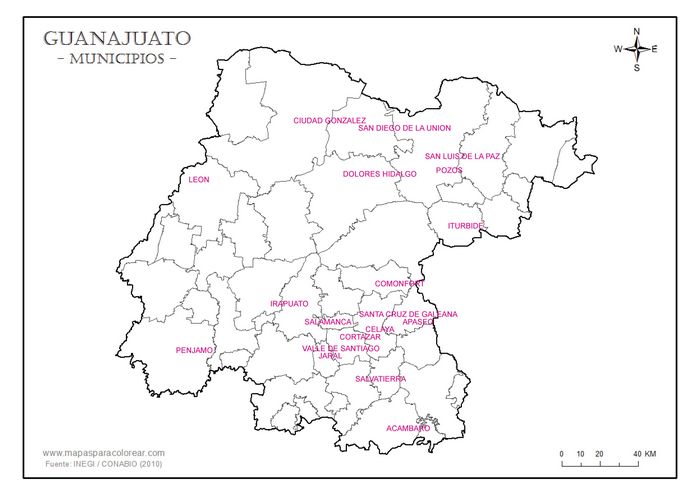Municipal issues

In addition to the Tesorería Municipal of the state capital, several municipalities in Guanajuato issued emergency currency during the revolution, often designated as a temporary measure and only for local use within the district. From surviving examples we can consider the following:
1. The issuer in most cases is stated to be the Tesorería Municipal (Acámbaro, Celaya, Comonfort, Cortazar, León, Salamanca, Salvatierra, Santa Cruz de Galeana and Valle de Santiago) whilst others are from the Municipio (Iturbide (with handstamp of the Tesorería Municipal), Pénjamo (with mention of the Tesorería Municipal), Pozos and San Luis de la Paz). One (Ciudad González) is from the Junta de Administración Municipal, which dates it to the governorship of José Siurob, from 11 May 1915 to the end of December 1916.
Some are from the Distrito (Dolores Hidalgo, Irapuato, Jaral, León (with handstamp or mention of the Tesorería Municipal) and Pozos) which was sometimes co-terminous with the municipio and sometimes composed of more than one municipios. Two (Apaseo and San Miguel de Allende) make no mention of the issuer, though San Miguel de Allende mentions the Presidente Municipal and Jefe de Armas and has a handstamp of the Tesorería Municipal.
2. These issues were usually backed by reserves, held in the Tesorería Municipal, such as a deposit made by local businesses (Comonfort) or otherwise (San Miguel de Allende and Irapuato), in Villista (Pozos) or Carrancista (Jaral) paper currency. One series in Celaya mentions that it was guaranteed by the Tesorería Municipal. As such their issues, numbers and values, and, if redeemed, withdrawal will have been meticulously recorded but unfortunately most of the municipal archives’ documentation from this period has been lost. However, this still leave us with the hope that new information will continue to emerge.
3. A couple of Acámbaro issues, Salamanca and Salvatierra mention that they were payable to the bearer on sight (though probably further regulations will have specified a minimum amount (five pesos?) for redemption.
4. Only Apaseo mentions that they were of forced circulation in the district, though this might have been presumed in other cases.
5. We know that Salvatierra was approved by governor Pablo M. de la Garza (governor from 5 August to 17 November 1914). Three others (Ciudad González, Dolores Hidalgo and Pozos) mention that they had approval of the state government: incidentally, these are more professionally produced. Elsewhere we have evidence of the central government asking for more details about these local issues.
6. Given that there is a limit to the number of ways one can arrange a title, legend and value there is still not much similarity between the various issues. This, together with the primitive appearance of most notes, suggests that not only were they for local circulation but also that they were printed locally. Thus, Acámbaro was printed by the Tipografia Artistica, Pozos and San Luis de la Paz by the imprenta S. Tristan, in nearby San Diego de la Unión, and Salvatierra by the Tipografia Mariana.
7. Some notes have a printed date and many were datestamped at issue. The dates range from May 1915 (Acámbaro) to up to December 1915 (Pozos) though we know that Salvatierra issued cartones several months earlier.
8. Some municipalities appear to have issued a sequence of notes, suggesting a long period of local issues, but these could have been in circulation at the same time.
